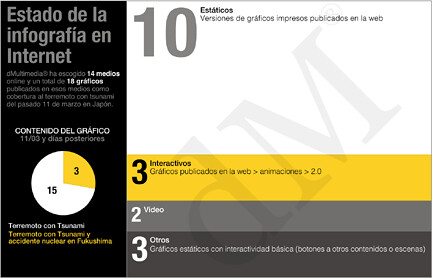
 (By Carlos Gamez Kindelan) These data refer to the period from the day of the earthquake, Friday March 3 to Sunday 5. I chose 14 / 2 18 different graphs of these media . This type of analysis is something I like to do from a young age. It is often enlightening in some sense and you always learn.
(By Carlos Gamez Kindelan) These data refer to the period from the day of the earthquake, Friday March 3 to Sunday 5. I chose 14 / 2 18 different graphs of these media . This type of analysis is something I like to do from a young age. It is often enlightening in some sense and you always learn. A simple Google search was showing me some charts, others such as nytimes.com for example, tracked by self-interest (something I do daily). What we can read these numbers? The news that we call 'breaking news' still important from the point of view of graphics. And since we only talk online territory, the importance is twofold. On the one hand, it shows that some media and do not hesitate to post your graphics on the Internet but are the same versions for print editions. This is what happens in most cases, on the other hand, one sees that more importantly the holder online chart that the very information covered in the chart. This I think only suggests that, in some cases a higher value chart positioning in the Google search engine to the chart itself. The sooner you post the url of your chart more likely to "succeed" in the race to be first on the website and get hits. This is not something new or I have invented myself. Just so, it may be that with some slight but true. Everyone knows that what it takes to make a static graphic or an interactive video. Prioritizing speed Internet there have plump graphics and new formats (eg so fashionable 'Towergraphics'). Never saw so many graphics on the web, especially those dealing with their own web, social networks, mobile devices and Apple iPad. These are, in general, news of those who speak the "new graphics" we see on the web. Why go out to document, interview and obtain information? Because Google and Twitter for good or ill give you all this. The new journalists know and know perfectly these new avenues of information and just get up from his seat rather than to go to a meeting or a coffee. With so much information flowing through the network is the problem of intoxication. It is very difficult to separate the wheat from the chaff and contrast sources is something for which there is little time, then copied the piece. But in addition to copy or obtain information from traditional means rigorous, sources in many cases are graphic or news published by companies away from journalistic rigor with which the quality of this work leaves much to be desired. We are all taught in schools of communication that were never rush an excuse to do wrong your work, to trust a misspelling or just because the first information that will come to hand. For all that is changing. Journalism, now, is called technology. And this must be taken into account.
Moreover you can also see computer graphics professionals still maintaining their way of work, professionalism and quality in day to day because they know how to avoid all this noise. They are experienced professionals, hardware work, school writers who have adapted to changes without changing their professionalism. And we also see media companies who support these professionals. Where do the best graphics that we see today? Of course these profiles.
This is not to say that everything we see on the web has to go directly to the trash. We also see very good examples and a boom in testing as never seen before on the Internet. But if all our work we rely on speed always closer to the static and interactive as analog and digital and see that 18 papers on the disaster in Japan, only 3 are interactive. After a long way to go and that's good for everybody.
0 comments:
Post a Comment